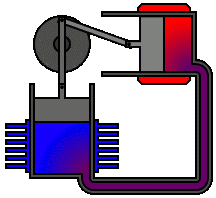Engines are truly wonders of mankind, they transform one form of energy into mechanical energy. In this sense, the first engines were wind and water mills, which date back to the first century BC at least. But it was really the industrial revolution that transformed the landscape of engine technology. Today’s engine powers cars and planes but also makes your phone vibrate. In this article we will talk about a particular kind of engine : the Stirling engine.
Here is a video of mine in action, all that is needed is a difference in temperature between the top and bottom plate. Here I used hot water and ice.
How do they work
The Stirling engine is a heat engine, this means it transforms heat gradients into mechanical energy. They were invented during the industrial revolution when steam engines did not yet take their place as the king of engines.
They work on a physical principle. You probably know that if you compress air it gets hot but the inverse is true if you warm air it dilates. This is what powers Stirling engines. They are made of a cold end, a warm end and two associated pistons, a rotor and an enclosed space with air inside. The engine works in 4 step which make up a cycle:
- (State : Cold piston extended; hot piston retracted) As the air warms up at the hot end it expands and pushes on the cold piston which retracts.
- (State : Cold piston retracting; hot piston extending) Since both piston are linked to the rotor and due to inertia the hot piston extends as the cold one retracts.
- (State : Cold piston retracted; hot piston extended) As the air cools down at the cold end it contracts and pulls on the cold piston which extends.
- (State : Cold piston extending; hot piston retracting) Since both piston are linked to the rotor and due to inertia the cold piston extends as the hot one retracts.

Stirling engines in real life
Theoretically, Stirling engines are more efficient than other engines. They can run on any heat or cold source and they don’t need air since there is no combustion. But in reality they often demand the use of exotic and costly materials. Moreover, they are heavier than other engines.
Even with these issues, some people tried to use these engines in cars and planes but with little success. Stirling engines can also be used as heat pumps : by forcing their rotor to turn, we can produce a difference in temperature between the cold and hot end.
The true success story for Stirling engines in the modern time is the Swedish Gotland-class submarines. This is because Stirling engines can be extremely quiet compared to diesel engines since they do not have internal combustion and sea water can be used to cool them down. Plus, these engines also do not produce waste gas on their own, which means they can run underwater. Diesel submarines have to come up to the surface to run their engine and charge their battery. In 2006, HSwMS Gotland proved the stealth capability of the stirling engine by virtually “sinking” the american super-carrier USS Ronald Reagan during a war-gaming exercise.
- Tokenization in LLMs: Why Not Use Words? - 6 March 2025
- Defining AGI : Why OpenAI’s o3 Isn’t Enough to achieve Artificial General Intelligence - 26 December 2024
- ChatGPT and Large Language Models : Key Historical Milestones in AI - 22 August 2024